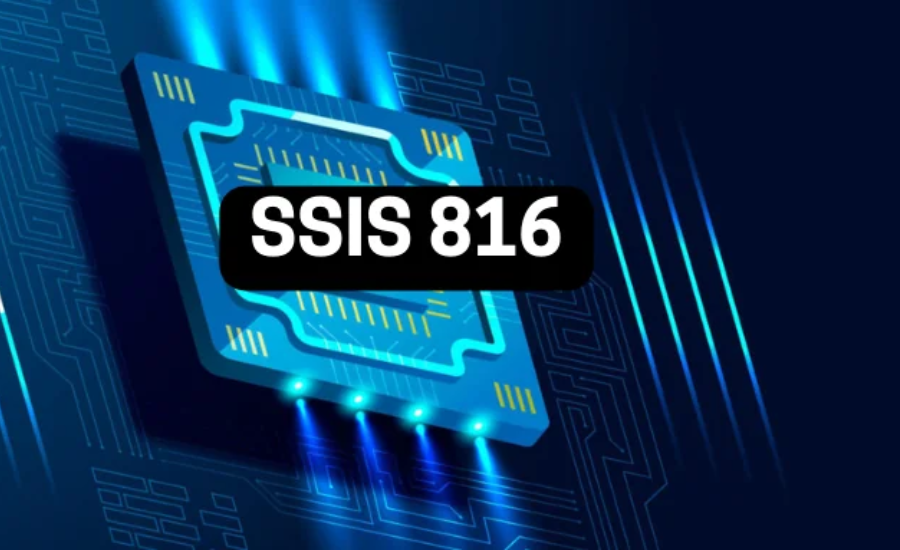Navigating the complexities of data integration can be daunting, especially when managing vast amounts of information. Fortunately, SSIS 816 simplifies this process, offering a robust solution for transforming and managing data more efficiently than ever before. Whether you’re a data professional looking to optimize existing processes or just beginning your journey in data integration, this guide will help you uncover the full potential of SSIS 816. Let’s explore its key features, benefits, and applications, while offering insights into how it can streamline your workflow and elevate your data management strategies.
Understanding SSIS 816: The Power of Integration Services

SSIS 816, part of Microsoft’s SQL Server suite, is a comprehensive tool designed to handle data integration through its Extract, Transform, Load (ETL) capabilities. This version builds on the foundation of previous SSIS iterations while introducing enhanced functionality aimed at streamlining data processing.
With SSIS 816, users can seamlessly connect to various data sources, such as Excel, flat files, relational databases, and even web services. This versatility makes it an ideal choice for consolidating diverse data sets into a centralized system for further analysis or reporting.
One of SSIS 816’s standout features is its user-friendly visual interface. With a simple drag-and-drop design, even those with minimal programming experience can create complex ETL workflows, eliminating the need for extensive coding. Additionally, built-in error handling mechanisms and support for parallel processing ensure that data integration tasks are carried out efficiently, even when dealing with large-scale datasets.
The Evolution of SSIS: From Origins to SSIS 816
The development of SSIS traces its roots back to 2005 when Microsoft first introduced it as part of the SQL Server offering. Over the years, SSIS has undergone numerous iterations to keep pace with emerging data integration needs. Each version, including SSIS 816, builds upon its predecessors with enhancements in performance, scalability, and usability.
The introduction of SSIS 816 marks a significant leap forward, with advanced support for cloud technologies and big data analytics. By leveraging cloud computing and big data tools, SSIS 816 allows for more efficient data processing both on-premises and in cloud environments. This evolution highlights Microsoft’s ongoing commitment to improving the way organizations manage and integrate their data, ensuring that SSIS remains a relevant and effective solution in today’s fast-moving digital landscape.
Key Features and Benefits of SSIS 816
SSIS 816 brings an impressive array of features that enhance the data integration experience. Here are some of the key benefits:
Versatile Data Source Connections: SSIS 816 supports integration with a wide variety of data sources, including SQL databases, flat files, APIs, and cloud-based systems, making it easier to pull data from multiple environments.
Intuitive User Interface: The visual design interface is one of the main draws of SSIS 816. With drag-and-drop functionality and a rich set of pre-configured tasks, users can build sophisticated data workflows without writing extensive code.
Robust Error Handling: SSIS 816 includes logging and error-handling features that help developers track issues during package execution, ensuring that data integrity is maintained and troubleshooting is more straightforward.
Scalability and Performance: SSIS 816 is designed for high-performance execution, capable of processing vast datasets through parallel processing techniques. This makes it an ideal solution for both small-scale and large-scale data integration projects.
Seamless Integration with Microsoft Tools: SSIS 816 works effortlessly with other Microsoft tools, such as SQL Server Management Studio (SSMS) and Visual Studio, enabling streamlined workflows across platforms.
These features make SSIS 816 a valuable tool for businesses seeking to automate and optimize their data integration processes, thereby saving time and improving data quality.
Upgrades and Enhancements in SSIS 816
SSIS 816 introduces several critical upgrades that set it apart from previous versions:
Enhanced Connectivity: The tool now supports a broader range of data sources, ensuring smoother integration across both legacy and modern systems.
Improved Performance and Scalability: Optimized execution means SSIS 816 can efficiently handle both high-volume data processing and complex transformations, making it suitable for any project size.
Stronger Security Measures: With robust encryption options and improved access controls, SSIS 816 ensures that sensitive data is protected throughout the integration process.
AI-Driven Integration: SSIS 816 begins to integrate artificial intelligence (AI) capabilities, allowing users to incorporate machine learning models into their workflows, enhancing data transformation and analysis.
These enhancements ensure that SSIS 816 remains a cutting-edge solution for data integration in today’s data-driven environment.
Getting Started with SSIS 816

Using SSIS 816 requires a few simple steps to set up and start integrating your data. Here’s how you can get started:
- Install SSIS 816: Download and install the SSIS 816 package on your system to begin using its features.
- Create a New Project: Open Visual Studio, choose the SSIS Project template, and define the project settings.
- Add Data Sources: Import data from various sources, such as databases or flat files, using SSIS’s built-in connectors.
- Design Your Workflow: Use SSIS’s control flow tools to organize tasks and define the sequence of operations.
- Configure Data Flow: Add transformation tasks to process and move data between systems.
- Test and Execute: Run your packages directly in Visual Studio or schedule them for automated execution.
- Monitor and Troubleshoot: Enable logging and implement error-handling strategies to ensure smooth execution.
By following these steps, you can fully harness SSIS 816’s potential to manage your data integration needs.
Popular Applications of SSIS 816
SSIS 816 is used across various industries for a wide range of applications:
Data Integration with SSIS 816
SSIS 816 stands out as a powerful solution for integrating data from various disparate sources into a unified, centralized system. Whether your data resides in relational databases, flat files, cloud storage, or external web services, SSIS 816 provides a seamless method to connect and extract valuable information. The tool’s wide array of connectors and integration options enables users to combine structured, semi-structured, and unstructured data from various platforms.
By centralizing your data in one location, you eliminate data silos, making it easier to access and analyze. This integration is particularly beneficial for organizations looking to streamline their data processing workflows, enhance reporting capabilities, and ensure that all relevant business units have access to the same set of accurate, up-to-date information. Moreover, SSIS 816 offers built-in transformation tasks, which allow for real-time data cleansing, ensuring that the data being integrated is high-quality and ready for immediate use.
Automating ETL Processes with SSIS 816
One of SSIS 816’s most powerful features is its ability to automate the entire ETL (Extract, Transform, Load) process, which is essential for businesses that rely on consistent and timely data flows. SSIS 816 enables developers to design intricate ETL workflows that automate the movement of data from source systems to destination environments, while simultaneously applying necessary transformations.
Developers can create complex logic for cleansing, aggregating, and transforming data, reducing the need for manual intervention. The drag-and-drop interface within SSIS 816 simplifies the creation of workflows, allowing even non-programmers to design sophisticated ETL processes. By automating these processes, SSIS 816 not only saves time but also reduces the risk of human error and ensures that data is processed in a consistent, repeatable manner.
This automation is particularly valuable in scenarios where large volumes of data need to be processed on a regular basis, such as nightly data updates, weekly reports, or monthly data migrations. Additionally, SSIS 816 allows for scheduling and monitoring of ETL tasks, ensuring that all processes run smoothly without requiring constant oversight.
Business Intelligence Powered by SSIS 816
SSIS 816 plays a critical role in business intelligence (BI) by facilitating the seamless integration of data from various sources, enabling organizations to build comprehensive data warehouses and BI solutions. With SSIS 816, businesses can gather data from diverse systems such as operational databases, external APIs, or cloud services, and transform it into a structured format that can be analyzed to uncover valuable insights.
By consolidating this data into a centralized data warehouse, SSIS 816 ensures that data is accessible, consistent, and ready for analysis. BI tools like Power BI or SQL Server Analysis Services (SSAS) can then be used to create rich visualizations, dashboards, and reports that empower decision-makers with actionable insights.
Moreover, SSIS 816 supports the integration of data from both internal and external sources, enabling organizations to combine internal transaction data with market research or social media data. This holistic view of organizational performance and external trends allows businesses to make more informed, data-driven decisions that are aligned with strategic goals.
Simplifying Data Migration with SSIS 816
Whether your organization is migrating from legacy systems, transitioning to the cloud, or upgrading to a new version of your database platform, SSIS 816 provides a simplified approach to data migration. Moving large volumes of critical business data can be a complex and time-consuming task, but SSIS 816 streamlines the process by offering pre-built connectors, transformation capabilities, and detailed logging for tracking progress.
The tool supports a wide range of source and destination platforms, allowing businesses to transfer data from older systems to modern cloud-based environments, such as Microsoft Azure, with minimal disruption. Furthermore, SSIS 816’s incremental loading feature ensures that only the data that has changed since the last migration is moved, reducing the time and resources required for large-scale migrations.
In addition to migrating data, SSIS 816 provides robust error-handling mechanisms to address any issues that may arise during the migration process. By automating the migration pipeline, organizations can ensure that data is transferred accurately and with minimal downtime, enabling a smooth transition to new systems or platforms.
Real-time Data Processing with SSIS 816
As businesses increasingly rely on real-time data to make quick decisions, SSIS 816 is an ideal solution for integrating and processing real-time data streams. While traditional ETL processes typically involve batch processing, SSIS 816 can handle real-time data integration, which is crucial in industries where timely insights are required, such as finance, e-commerce, and healthcare.
SSIS 816 facilitates the integration of streaming data from sources like IoT devices, financial market feeds, or customer interaction logs, allowing businesses to capture and process data as it is generated. This real-time capability enables organizations to monitor operational performance, detect anomalies, and respond to business events as they happen.
For example, in an e-commerce scenario, SSIS 816 can integrate real-time customer data from website interactions and transactions, providing immediate insights into customer behavior. In healthcare, SSIS 816 can process patient data from medical devices in real-time, enabling faster decision-making in critical care situations.
By incorporating real-time data processing, SSIS 816 ensures that businesses can stay agile and responsive in today’s fast-paced environment, turning raw data into meaningful insights as events unfold.
Overcoming Challenges with SSIS 816

Despite its robust feature set, SSIS 816 has certain limitations that users should be aware of:
Learning Curve: SSIS 816’s powerful features require a certain level of expertise to navigate, which may pose a challenge for beginners.
Real-time Data Integration: While SSIS 816 excels at batch processing, its capabilities for real-time data integration are still limited compared to other solutions.
Scalability for Very Large Datasets: While SSIS 816 handles moderate data volumes well, extremely large datasets may present performance challenges.
Platform Compatibility: SSIS 816 is optimized for Windows environments, which can make integration with non-Microsoft systems more difficult.
The Future of SSIS 816
Looking ahead, SSIS 816 is poised for continued innovation:
Cloud and Hybrid Environments: As more organizations move to the cloud, SSIS 816 will continue to evolve with tighter integration with cloud platforms like Azure.
Incorporating AI and Automation: Expect more AI-driven features that will further automate complex ETL tasks, enhancing data transformation processes.
Enhanced Security: With increasing data privacy concerns, SSIS 816 will likely continue to improve its security features to meet the growing demand for secure data management.
FAQs about SSIS 816
Q: What is SSIS 816, and how does it differ from previous versions of SSIS?
A: SSIS 816 is the latest iteration of Microsoft’s SQL Server Integration Services (SSIS), a robust tool designed for data integration and ETL (Extract, Transform, Load) operations. It enhances previous versions by introducing advanced cloud support, improved performance, scalability, and AI-driven features. It offers better connectivity to a variety of data sources and integrates seamlessly with other Microsoft tools, allowing for more efficient data processing, management, and transformation.
Q: What types of data sources can SSIS 816 connect to?
A: SSIS 816 supports a wide variety of data sources, including relational databases (SQL Server, Oracle, MySQL), flat files, Excel, APIs, cloud platforms like Azure, and web services. Its versatile connectivity options allow users to consolidate data from diverse environments, making it suitable for a wide range of data integration scenarios.
Q: How user-friendly is SSIS 816 for beginners?
A: While SSIS 816 features a visual interface that simplifies workflow design through drag-and-drop functionality, there is a learning curve associated with mastering the tool. Beginners may need time to familiarize themselves with its various components, but the intuitive interface, along with numerous tutorials and online resources, can help ease the learning process.
Q: Can SSIS 816 handle real-time data processing?
A: SSIS 816 supports both batch processing and real-time data integration, although its capabilities for real-time processing are not as extensive as specialized real-time data platforms. However, SSIS 816 can handle data streams from sources such as IoT devices, financial market feeds, and customer interactions, enabling timely decision-making for industries like finance, e-commerce, and healthcare.
Q: How scalable is SSIS 816 for large datasets?
A: SSIS 816 is highly scalable and capable of handling large datasets by utilizing parallel processing techniques. However, performance may be impacted when processing extremely large datasets or complex transformations. It is best suited for medium to large-scale data integration projects, but users may need to consider performance optimizations or alternative solutions for exceptionally massive datasets.
Conclusion
SSIS 816 is a powerful data integration tool within the Microsoft SQL Server suite, designed to streamline the process of extracting, transforming, and loading (ETL) data from diverse sources into centralized systems. With its user-friendly drag-and-drop interface, broad data source connectivity, and advanced features such as AI-driven integration, SSIS 816 helps businesses automate and optimize their data workflows. Key upgrades include enhanced cloud compatibility, improved performance, robust security, and AI integration. It plays a vital role in business intelligence, data migration, and real-time data processing, offering scalability and efficient automation. Despite some challenges, such as a learning curve and Windows platform dependence, SSIS 816 remains an essential tool for organizations to manage and leverage data for informed decision-making and operational success.
Read Next: wizzydigital-org
